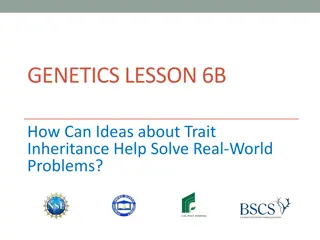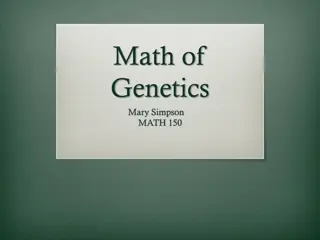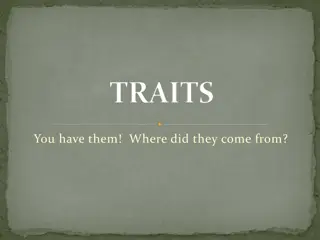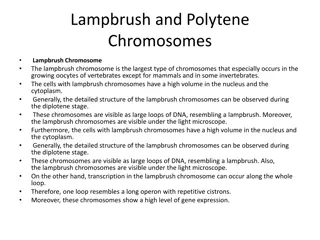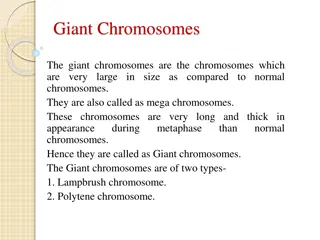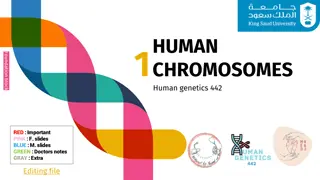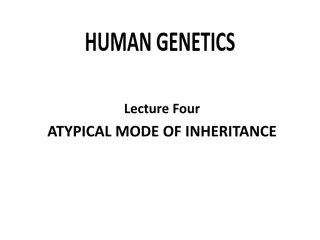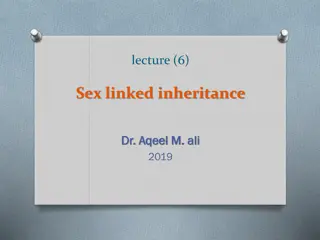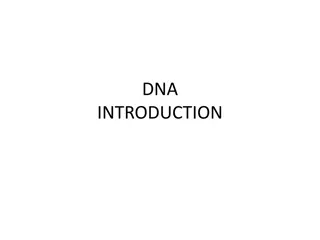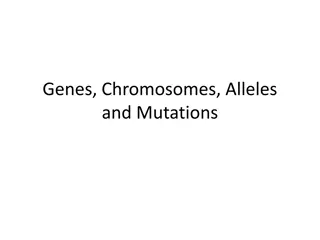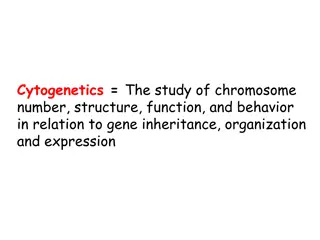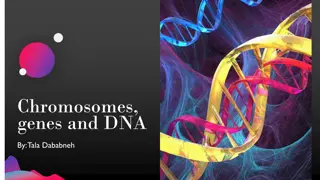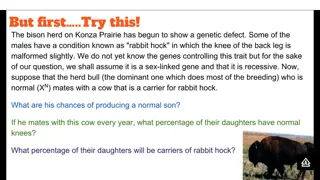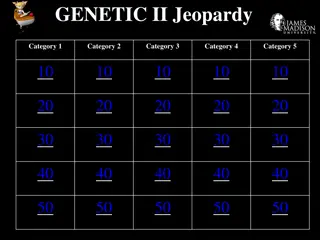Understanding Genetics: Chromosomes, Genes, and Inheritance
Genetics encompasses the study of chromosomes, genes, and inheritance patterns. Chromosomes are bar-like structures carrying DNA, with homologous pairs determining traits. Autosomes and sex chromosomes play roles in genetic makeup. Genes are hereditary units determining individual traits, with alleles representing different gene forms. Genotypes reflect allele combinations, while phenotypes manifest genetic expressions. Inheritance can be dominant-recessive, seen through Punnett Squares. Explore the fascinating world of genetics through this comprehensive guide.
Download Presentation

Please find below an Image/Link to download the presentation.
The content on the website is provided AS IS for your information and personal use only. It may not be sold, licensed, or shared on other websites without obtaining consent from the author. Download presentation by click this link. If you encounter any issues during the download, it is possible that the publisher has removed the file from their server.
E N D
Presentation Transcript
Genetics A. The Vocabulary of Genetics 1. Chromosome bar-like structures of tightly coiled chromatin (DNA), visible during cellular division 2. Homologous chromosomes chromosomes that carry the same genes and determine the same traits. In a human, there are 23 homologous chromosome pairs for a total of 46 chromosomes.
Genetics A) Autosomes of the 23 pairs of chromosomes present in human cells, 22 pairs of them have nothing to do with the sex of the individual. B) Sex chromosomes of the 23 pairs of chromosomes present in human cells, 1 pair determines the sex of the individual. 3. Gene one of the biological units of heredity that determines the traits of an individual.
Genetics 4. Alleles different versions or alternate forms of a gene (example: blue eyes, brown eyes, green eyes, etc). Alleles are often designated as being dominant or recessive. A) Dominant alleles can mask the effects of other alleles (ex: widow s peak). These alleles are always designated with a capital letter such as A .
Genetics B) Recessive alleles are easily masked by the effects of other alleles (ex: straight hairline). These alleles are always designated with a lower case letter such as a . 5. Genotype a person s combination of alleles. A) Homozygous dominant the person possesses two dominant alleles (AA).
Genetics B) Heterozygous the person possesses one dominant allele and one recessive allele (Aa). C) Homozygous recessive the person possesses two recessive alleles (aa). 6. Phenotype a person s physical expression of their genetic make-up (genotype).
Genetics A) A homozygous dominant person shows the dominant trait on the outside. B) A homozygous recessive person shows the recessive trait on the outside. C) A heterozygous person often shows only the dominant trait on the outside because the dominant allele masks the presence of the recessive.
Genetics B. Types of Inheritance 1. Dominant-Recessive Inheritance A) This type of inheritance is common with traits like hitchhiker thumb, rolling the tongue, hairline, PTC tasting, etc. B) In every case, the dominant trait masks the recessive.
Genetics C) Punnett Squares are useful tools for determining genetic inheritance of dominant/recessive traits. 1) However, Punnett Squares only predict the probability that offspring will have a particular genotype or phenotype. 2) The larger the number of offspring, the more likely that the ratios will conform to the predictions.
Genetics 2. Incomplete Dominant Inheritance A) Recessive traits are not masked in the heterozygous form. Instead, a third phenotype (different from either the dominant or recessive one) is produced. B) Ex: A + B = C (Red flowers + White flowers = Pink flowers)
Genetics D) Sickle cell anemia is a human condition associated with this type of inheritance where the intermediate form has sickle cell trait but not full blown sickle cell disease. 3. Codominant Inheritance and Multiple Alleles A) There are some traits that demonstrate more than two dominant alleles. B) Blood type is a common multiple allele pattern of inheritance.
Genetics C) Because two alleles are dominant neither has the ability to mask the other; instead they are codominant and mixture of the two alleles shows up in the phenotype of the offspring. D) Ex: A + B = AB (Red flower + White flower = Red flower with white spots)
Genetics 4. Sex-linked Inheritance A) All of the other patterns of inheritance mentioned above are demonstrations of genes carried on autosomal chromosomes and an individual has equal chances of getting the gene whether that person is male or female.
Genetics B) Sex-linked inheritance however, demonstrates traits that are carried on the sex chromosomes and an individual s chance of getting the trait varies with the sex of the individual. C) Most sex-linked traits are carried on the X chromosome while very few are carried on the Y chromosome.
Genetics D) X-linked traits affect both males and females because both sexes will receive at least one X in their genotype (XX=females; XY=males). 1) Ex: hemophilia and color blindness E) Y-linked traits only affect males because females do not receive a Y chromosome. 1) Ex: hair on the ear lobes
Genetics 5. Polygenic Inheritance A) Polygenic inheritance is the result from several different gene pairs at different locations within the genetic makeup work together to produce a particular phenotype. B) Ex. over 150 different genes influence eye, hair and skin colors.
Genetics C) Different combinations produce variations in skin color from dark skin to light skin. 6. However, environment can affect the expression of genes. A) Maternal drug use can alter normal gene expression during embryonic development. B) Nutrition and diet C) Hormonal deficits and excesses
Genetics C. Sources of Genetic Variation 1. Mendel s Law of Segregation A) Each organism contains two factors (alleles) for each trait and these randomly align along the metaphase plate. B) The factors then segregate during the formation of gametes so that each gamete contains only one factor for each trait.
Genetics C) This reshuffling of the factors helps explain how variations come about and why offspring differ from their parents. 2. Law of Independent Assortment A) Members of one pair of factors separate independently of members of another pair of factors. B) Therefore, all possible combinations of factors can occur in the gametes.
Genetics 3. Crossing over of homologous genes A) During Meiosis I (prophase I), two of the four chromatids (one maternal & the other paternal) may cross over at one or more points and exchange corresponding gene segments. B) The recombinant chromosomes contain new gene combinations, adding to the variability arising from independent assortment.
Genetics 4. Random Fertilization A) The third source of genetic variation is random fertilization of eggs by sperm. B) When just considering independent assortment, crossing over and random fertilization, any resulting offspring represents one out of the close to 72 TRILLION zygotes possible.


